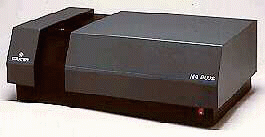
| Method | Photon Correlation Spectroscopy (PCS) |
| Size Range | 3 nm - 3 Ám in one measurement |
| Typical Applications | Latex, Liposomes, Microemulsions, Pigments, Polymer dispersions, Proteins and other colloidal systems |


N4 PLUS
Submicron Particle Size AnalysisMethod Photon Correlation Spectroscopy (PCS) Size Range 3 nm - 3 Ám in one measurement Typical Applications Latex, Liposomes, Microemulsions,
Pigments, Polymer dispersions,
Proteins and other colloidal systems
Ideal for the rapid Quality Control of single, multi-modal or broad distributions.
Ideal for the rapid identification of different suspensions or emulsions.
N4 Plus Output Data Analysis Modes Particle Size Unimodal Distribution Width (Cumulants method) Polydispersity SDP (CONTIN Program) Diffusion Constant
The N4 Plus Combines User Friendly Software With Patented, Multi-angle Measurement
For Increased Accuracy And Highly Dependable Particle Size Data.
Accurate submicron particle sizing without hidden surprises.
If particles in the submicron range are part of your production or product development process, measurement and control of particle size is important to you. You need an analyzer that can reliably detect the component populations in your sample every time. The N4 Plus uses Photon Correlation Spectroscopy (PCS), which determines particle size by measuring the rate of fluctuations in laser light intensity scattered by particles as they diffuse through a fluid. PCS is the only nondestructive method for measuring particle size down to a few nanometers, and the COULTER N4 Plus is the only commercially available PCS analyzer that won't leave you wondering whether or not you really know what's in your sample.
Only multi-angle PCS analysis can reveal all the particle populations in your sample.
The N4 Plus is the only PCS analyzer that uses six fixed measurement angles. Most PCS analyzers perform measurements at only 90 degrees. Because submicron particles scatter light in patterns depending on particle size, larger particles may be difficult to detect at 90 degrees if the sample contains a large number of smaller particles. Similarly, any population of particles that scatter weakly at a certain angle may be masked by particles with strong scattering at that angle. For this reason, single or dual angle PCS instruments provide only a partial view of your sample. Adjustable-angle instruments (goniometers) are prone to inaccuracy, in addition to being cumbersome.
Whether you are trying to characterize the results of a process in R&D, or monitoring for contamination on the production line, only the multi-angle N4 Plus can consistently and accurately characterize your sample.
A powerful laser detects the most elusive particles.
The N4 Plus also incorporates a powerful 10mW laser which permits easy analysis of even the weakest light scatterers such as micelles and single polymer chains.
The N4 Plus software provides a flexible and user-friendly interface.
- User-friendly Microsoft Window-based software includes these features:
- Run Profiles to automate frequently used analysis protocols.
- Database to organize data in a lab-oriented hierarchy and free operators
from 8-character DOS filenames.- Real time display of instrument status including mode of operation, time
remaining in current measurement, and time remaining in entire analysis.- Easy-to-read printout of user-defined reports to any printer supported by
Windows 3.1.- Comparison of results from different runs by overlays.
- Automatic fluid parameter tables include commonly used fluid refractive index
and viscosity data.Two analysis modes provide flexibility.
The N4 Plus can provide you with the mean particle size in your sample, along with the estimated distribution width, in just 60 seconds. For a complete particle size distribution, the Size Distribution Processor (SDP) analysis resolves the components of polydispersed samples and reports results in Intensity % or Weight % as a function of particle diameter or molecular weight.
It doesn't take sophisticated operating skills to get sophisticated results.
Because of the N4 Plus' fully automated design, even novice operators can use the instrument immediately and obtain meaningful results. And, while best settings for most run parameters are automatically determined, manual options are also available for more knowledgeable users.
Technical Specifications
Sample:
Liquid suspensionsSample particle size range:
0.003 µm to 3 µm diameterAnalysis modes:
1) Unimodal (cumulants) fit yields mean particle size and standard deviation in nm. Reproducibility: typically better than 3% CV.2) Size distribution profile deconvolution algorithm based on CONTIN program yields peak data and bin by bin percentage (intensity or weight) as a function of particle size or molecular weight. Resolution: 17 to 31 size bins, user-selectable. Reproducibility: sample dependent.
Instrument control and data storage:
Microsoft Windows based PC software. Data stored in ODBC-compliant (Open Databased Connectivity) database. Automatic configuration of run parameters.Laser source:
10 mW helium-neon 632.8 nmOptics:
Six fiber optics located at the following geometrical angles: 14.9°, 20.6°, 30.4°, 40.2°, 50.4°, and 90°. User-selectable. Auto-stepping motor routine for sequential angle analysis.Temperature control:
0°-90° C ±0.2°C, Peltier (electronic) regulated.Correlator:
80 Multi-Tau channels; 3072 linear channels equivalent, 48 bit/channel.Interface:
RS-232C serial interface is standard. Baud rate is software-selectable, up to 19.2K Baud.Power requirements:
115/230 Vac, 50/60 HzEnvironmental operating specs:
Temperature: 10-40°C
Humidity: 0-90% w/o condensation
Controls, Standards and Accessories




© Coulter International Corporation, 1996. All rights reserved. Copyrights and Trademarks
 |
 |
 |
 |